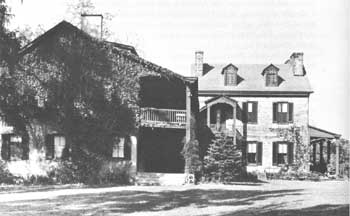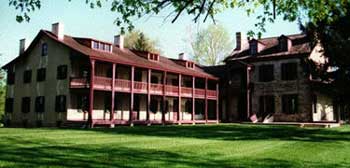





Survey of Historic Sites and Buildings
  |
FRIENDSHIP HILL NATIONAL HISTORIC SITE Pennsylvania |
 Friendship Hill National Historic Site |
| ||
Significance. This mansion was the home of Albert Gallatin—distinguished Secretary of the Treasury, statesman, and diplomat—whose statue today stands in front of the Treasury Department building in Washington, D.C. Born and raised in Geneva, Switzerland, and member of a very prominent family, Gallatin, at the age of 18, emigrated to the United States, where he sought to fulfill his idealistic dream of a democratic society unblighted by monarchy. After landing in Massachusetts, in 1780, he engaged in trading in Maine; taught French at Harvard; and in 1784 opened a store on the Pennsylvania frontier, where he lost most of his money in highly speculative and unprofitable land purchases.
In 1788 Gallatin purchased Friendship Hill, entered politics, and served at the Harrisburg convention called to consider sending a resolution to Congress requesting revisions in the U.S. Constitution, which Pennsylvania had already ratified. At a subsequent convention, held in 1789-90 to revise the Pennsylvania constitution, Gallatin supported measures to enhance the power of the people and limit that of the executive. While serving in the Pennsylvania Legislature, in 1790-92, he fought for better public education, prison reform, abolition of slavery, and improved fiscal management. Elected to the U.S. Senate in 1793, he was ousted by the Federalists, who claimed he had not been a citizen long enough to serve. Returning to Pennsylvania, in the throes of the Whisky Rebellion (1794), he played a big part in subduing it and preventing civil war. During the years 1794-1800, as a Member of the U.S. House of Representatives, he initiated various fiscal reforms, many of which are still in effect today. His interest in the control of national finances resulted in the creation of the House Ways and Means Committee.
 |
| Friendship Hill, Pennsylvania. Albert Gallatin, statesman and Secretary of the Treasury, purchased this mansion in 1788 and lived in it for many years. Courtesy, U.S. Bureau of Outdoor Recreation. |
From 1801 until 1814 Gallatin served with distinction as Secretary of the Treasury under Jefferson and Madison, during which time he vigorously applied his fiscal theories to advance his social ideas. He hoped to abolish the national debt, and an amazing increase in trade during the years 1802-7 enabled him to decrease it by millions of dollars, even after various internal taxes had been abolished. In 1808 he initiated a $20 million Federal road and canal building program, which never came to fruition.
When the War of 1812 cut heavily into the budget, Gallatin realized the impracticability of eliminating the national debt and in 1813 began a new career as diplomat. In that year President Madison appointed him to a commission treating Anglo-American conflict. The commission was to have met in St. Petersburg, but Britain refused to attend. Subsequently, as Minister to France and to Great Britain, Gallatin showed exceptional ability as a diplomat, especially in helping to negotiate the Treaty of Ghent. After returning to the United States in 1823 and selling Friendship Hill, he retired from public service, except for occasional diplomatic missions. Settling in New York City, he attempted to create a city university, founded the American Ethnological Society, and from 1844 until his death served as president of the New York Historical Society. He died in 1849, at the age of 88, still actively interested in national affairs.
 |
| Friendship Hill. |
Present Appearance. Friendship Hill consists of three sections: the original brick structure of unknown date that stood when Gallatin purchased the estate in 1788; a stone section that he added in 1823-24; and another section added at an unknown date after Gallatin sold the house.
In Nov. 10, 1978, Public Law 95-625 authorized Friendship Hill National Historic Site. During the summer of 1979, arson fires extensively damaged portions of the main house and destroyed the nearby gardener's cottage. In January, 1980, title to the property was passed to the National Park Service. Between 1982 and 1987, emergency repairs were made to stabilize the house, and the park was also open to the public on a part-time basis. Restoration of the Gallatin House was performed between 1987 and 1992, along with construction of a ranger residence.
NHL Designation: 01/12/65
 |
 |
http://www.cr.nps.gov/history/online_books/founders-frontiersmen/sitea27.htm
Last Updated: 29-Aug-2005